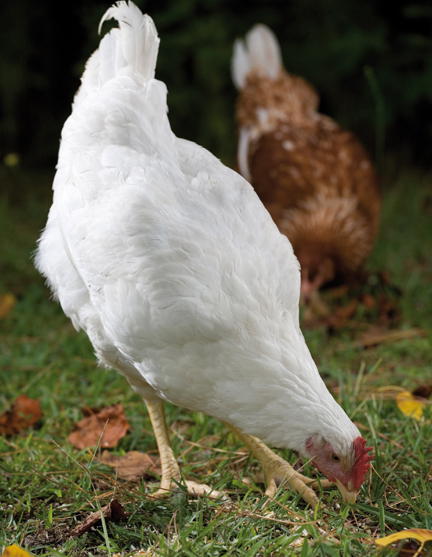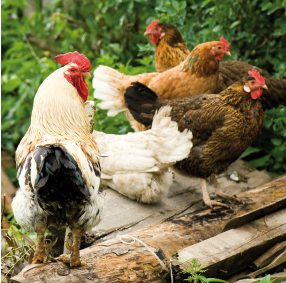Picking up Chicks: What to Know Before You Embark on Backyard Chicken Ownership

 Our family’s move from a bustling Northern Virginia suburb to a five-acre “farmlet” across the state would not have been complete without chickens. Even before we contemplated the move, I had my eye on a space-age coop from Omlet.com that would fit nicely in our postage stamp of a backyard. A friend in Tampa enticed me with tales of the blue, green and pink eggs she collected daily from the two hens occupying her backyard. I had visions of my four children skipping down to the coop at dawn, eagerly collecting the fresh eggs and pulling cartons of eggs around the neighborhood in a little red wagon, earning spending money. Four years and two flocks later, I’ve learned a thing or two about keeping chickens. So here it is: the good, the bad and the funny of raising chickens.
Our family’s move from a bustling Northern Virginia suburb to a five-acre “farmlet” across the state would not have been complete without chickens. Even before we contemplated the move, I had my eye on a space-age coop from Omlet.com that would fit nicely in our postage stamp of a backyard. A friend in Tampa enticed me with tales of the blue, green and pink eggs she collected daily from the two hens occupying her backyard. I had visions of my four children skipping down to the coop at dawn, eagerly collecting the fresh eggs and pulling cartons of eggs around the neighborhood in a little red wagon, earning spending money. Four years and two flocks later, I’ve learned a thing or two about keeping chickens. So here it is: the good, the bad and the funny of raising chickens.
Before you get your heart set on a backyard flock, check your local zoning ordinances and your neighborhood covenants to make sure your new hobby is legal. Localities often limit the number of chickens you can keep, prohibit roosters and have setback requirements. You may also want to survey the folks next door. Chickens can make for noisy, messy companions and unless there is adequate space between houses or you have laid-back, chicken-loving neighbors, your flock may cause unwanted tension.
 Assuming all is in order from a legal standpoint, you should carefully weigh the pros and cons of chicken ownership. One obvious check in the pro column is a continuous supply of fresh, healthy eggs. When the cupboards are bare, you will always have eggs, and not just any eggs, but ones with bright yellow, almost orange yolks from chickens whose food source is well known to you. Raising chickens can be a wonderful lesson in responsibility and a taste of farm life for citified kids, and if you produce enough eggs to sell, those little entrepreneurs in your family can look forward to a steady supply of dollar bills as a dozen fresh eggs can go for $2-3 per dozen.
Assuming all is in order from a legal standpoint, you should carefully weigh the pros and cons of chicken ownership. One obvious check in the pro column is a continuous supply of fresh, healthy eggs. When the cupboards are bare, you will always have eggs, and not just any eggs, but ones with bright yellow, almost orange yolks from chickens whose food source is well known to you. Raising chickens can be a wonderful lesson in responsibility and a taste of farm life for citified kids, and if you produce enough eggs to sell, those little entrepreneurs in your family can look forward to a steady supply of dollar bills as a dozen fresh eggs can go for $2-3 per dozen.
As chicken owners, you could come to tout yourself as the greenest gardener on the block, as nothing beats chickens for backyard pest control and fertilization. They will feast on your unwanted ticks, grubs and other insects and their waste, if composted, can fertilize as well as anything you could buy. They will also eat just about anything you throw their way, becoming a wonderful way to rid yourself of kitchen scraps and weeds. Michelle Meinhart, a Roanoke chicken owner, says her chickens love to snack on juicy bug morsels from the weeds she throws in her hen house before scarfing down the weeds themselves. She also is able to fertilize her garden with a compost pile near the hen house where she disposes of all their castoffs.
A lesser-known benefit of chicken ownership: having built-in backyard comedians. Despite their bird brains, chickens have distinct personalities and their antics have given our family plenty of laughs. For example, when we put denim “hen saddles” on our hens to prevent them from pecking each other, we found it hilarious when one chicken responded to her new duds by frantically running backwards. We get a kick out of watching them fight over grubs and pecking order. And chicken ownership has caused me as a mother to say things I never predicted would cross my lips such as “No, you cannot jump on the trampoline with a chicken;” “Get the chicken OUT of the pool;” and the now-classic, “Why are there feathers in the powder room?”
As Lynn Sowers of Southern States points out, chickens are a pet that pays you back. She emphasizes that anyone can raise chickens – she has assisted city folk, country folk and people from all different occupations in starting their backyard flocks. “Even folks with allergies can have chickens,” Lynn says. So if you have dander allergies, why resort to a hypoallergenic Bichon-Frise or a hairless cat when you can enjoy a flock of feathered friends?
In the con column, chickens do require a degree of daily maintenance. Lynn advises that chickens require daily feeding and watering, and that eggs need to be collected daily. Chickens can also be messy. Our chickens range free, which translates to poop on the driveway, poop on the front porch, poop, well, pretty much everywhere (including on our neighbor’s hot tub cover). They scratch mulch out of landscaped beds and newly-planted seeds out of gardens, and they eat tender greens, tomatoes and other produce, so if you appreciate a manicured lawn and garden, free-ranging chickens may not be for you. Chickens can be loud, breaking into an “egg song” before laying. Roosters, of course, are even noisier. You don’t need a rooster to keep egg-laying hens. Indeed, Michelle Meinhart, the Roanoke chicken lover, warns against keeping roosters because in addition to the noise, they are known to be aggressive. Finally, as with other pets, you must arrange for someone to tend to them when you travel and deal with the heartbreak (and the carcass) when they pass.
 Although a pet chicken could live an average of 7 to 12 years, most will succumb to predators long before that. Common predators of backyard chickens include neighborhood dogs, domestic and feral cats, hawks, owls, foxes, coyotes, bobcats, possum, raccoons, weasels, ermine, minks, snakes and rats. However, there are ways to secure your coop against predators. First, your coop should have a door that shuts securely at night. A trench around the coop lined with hardware cloth will deter digging predators such as possum, and an elevated coop will prevent mice, rats and weasels from entering. Avoid luring predators by cleaning up any food scraps that the chickens don’t finish before nightfall, and scare away unwanted nighttime visitors with motion sensor lights. Finally, if you have chicken hawks and owls in your area, cover your run with bird netting to keep them from scooping up your birds.
Although a pet chicken could live an average of 7 to 12 years, most will succumb to predators long before that. Common predators of backyard chickens include neighborhood dogs, domestic and feral cats, hawks, owls, foxes, coyotes, bobcats, possum, raccoons, weasels, ermine, minks, snakes and rats. However, there are ways to secure your coop against predators. First, your coop should have a door that shuts securely at night. A trench around the coop lined with hardware cloth will deter digging predators such as possum, and an elevated coop will prevent mice, rats and weasels from entering. Avoid luring predators by cleaning up any food scraps that the chickens don’t finish before nightfall, and scare away unwanted nighttime visitors with motion sensor lights. Finally, if you have chicken hawks and owls in your area, cover your run with bird netting to keep them from scooping up your birds.
 If after weighing the pros and cons you’ve decided to take the plunge, do some research on breeds and basic chick care. Backyardchickens.com is a wonderful resource for all things poultry including information on breeds, a learning center, and a forum where chicken owners can ask and answer questions. We love our Aracauna, easily identifiable by the fluffy feathers around their head, because they are hardy, friendly and lay gorgeous, colorful eggs. Other popular breeds include Rhode Island Reds with their rust-colored feathers and reputation as the best layer of brown eggs; Leghorns who have the highest rate of lay for white eggs but can be flighty and noisy; Plymouth Rocks, a great starter bird who are friendly, docile and striking with black and white stripes; and Silkies, a novelty breed with furry feet. Mypetchicken.com even has a fun, interactive quiz that will pair you with your poultry soul mate. We purchased our chicks from McMurray Hatchery at www.mcmurrayhatchery.com and requested a straight run of females to avoid having to dispose of a rooster. If you buy chicks online, you will be summoned to the post office to pick up your chirping package of peeps when it arrives. Most Southern States locations sell baby chicks in the spring. The Troutville location even has a livestock swap every fourth Saturday during the spring through late summer where folks can buy, sell and trade their chickens.
If after weighing the pros and cons you’ve decided to take the plunge, do some research on breeds and basic chick care. Backyardchickens.com is a wonderful resource for all things poultry including information on breeds, a learning center, and a forum where chicken owners can ask and answer questions. We love our Aracauna, easily identifiable by the fluffy feathers around their head, because they are hardy, friendly and lay gorgeous, colorful eggs. Other popular breeds include Rhode Island Reds with their rust-colored feathers and reputation as the best layer of brown eggs; Leghorns who have the highest rate of lay for white eggs but can be flighty and noisy; Plymouth Rocks, a great starter bird who are friendly, docile and striking with black and white stripes; and Silkies, a novelty breed with furry feet. Mypetchicken.com even has a fun, interactive quiz that will pair you with your poultry soul mate. We purchased our chicks from McMurray Hatchery at www.mcmurrayhatchery.com and requested a straight run of females to avoid having to dispose of a rooster. If you buy chicks online, you will be summoned to the post office to pick up your chirping package of peeps when it arrives. Most Southern States locations sell baby chicks in the spring. The Troutville location even has a livestock swap every fourth Saturday during the spring through late summer where folks can buy, sell and trade their chickens.
 Your new peeps will need to be kept inside for a period in a “brooder box” under a heat lamp with a food and water source. The box should have at least 2 square feet of space per chick. With our first flock, we made a chicken condominium out of several cardboard boxes. We put pine shavings in the bottom of the box and laid paper towels on top of the shavings, changing the towels when they were soiled. Our second flock enjoyed larger accommodations in a homemade brooder box. You can also get creative, housing your chicks in a bathtub, kiddie pool or large plastic bin. You will need to purchase bedding, feed, an automatic feeder and water container and a heat lamp from a local feed store. Your local Southern States store can supply everything you need to get started.
Your new peeps will need to be kept inside for a period in a “brooder box” under a heat lamp with a food and water source. The box should have at least 2 square feet of space per chick. With our first flock, we made a chicken condominium out of several cardboard boxes. We put pine shavings in the bottom of the box and laid paper towels on top of the shavings, changing the towels when they were soiled. Our second flock enjoyed larger accommodations in a homemade brooder box. You can also get creative, housing your chicks in a bathtub, kiddie pool or large plastic bin. You will need to purchase bedding, feed, an automatic feeder and water container and a heat lamp from a local feed store. Your local Southern States store can supply everything you need to get started.
If you don’t already have a coop, purchase or build your own while your chickens are living inside. Building a coop can be a fun and creative project. We’ve known folks who have built everything from wheeled chicken chariots to traditional miniature red barns. Tractor Supply provides a variety of kits and plans on its website. For $889 plus shipping, Moderncoop.com sells a sporty, reclaimed cedar coop you can move around your yard, providing fresh scratching ground for your chickens. Designercoops.blogspot.com sells customized coops complete with windows, a balcony and operational shutters where your chickens can reside in complete luxury.
Once your babies are ready to fly your coop for theirs, they may still need a heat source. We ran an extension cord from our house to a heat lamp in the coop for the first few weeks. Your coop should have enough room for your chickens (4-10 square feet per bird depending on whether they are able to roam free), bedding such as shavings or hay, protection from predators, a roost, ventilation, a covered run and a food and water source. You can expect to enjoy the benefits of the pet that pays you back in about four months as chickens start producing an average of one egg per day, although production slows in the winter months. Egg production peaks at two years and declines thereafter, so in all likelihood, you’ve now set yourself up with hens that will continue to lay for several years.
It’s easy to see why backyard chickens have become all the rage with families focused on healthy living and sustainability. Although my initial fantasies of skipping children carrying egg baskets hasn’t exactly panned out, I wouldn’t trade our experience of chicken farming and the fresh eggs we are able to enjoy, give and make into delectable concoctions. My kids may tire of the work involved in proper chicken care, but at least my husband appreciates a breakfast of fresh eggs, spinach, arugula, tomatoes and peppers – all from our backyard.
For a printable list of local zoning information and sources for coops and supplies, please click here.






